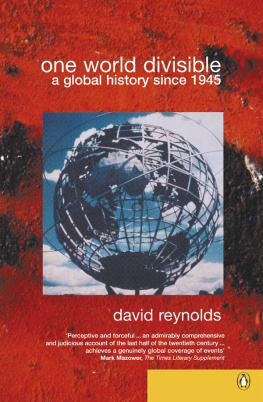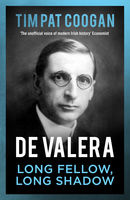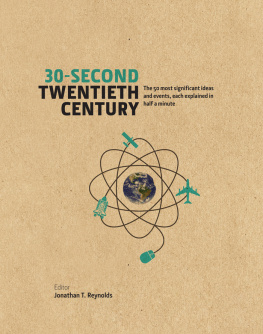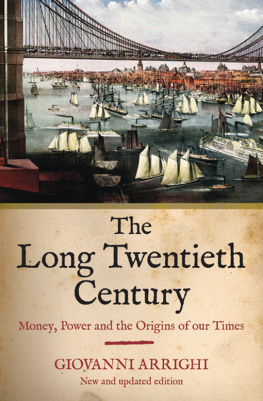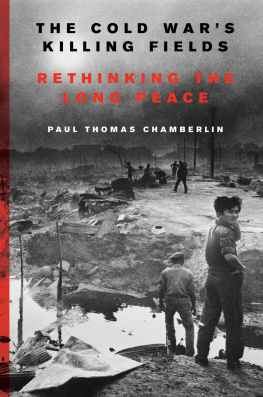THE LONG SHADOW
THE LEGACIES OF THE GREAT WAR IN
THE TWENTIETH CENTURY
David Reynolds

W. W. NORTON & COMPANY NEW YORK LONDON

Henry George Reynolds
(18821959)
James Kay
(18941928)
We step from days of sour division
Into the grandeur of our fate.
LAURENCE BINYON
From THE FOURTH OF AUGUST (1914)
Remember me when I am dead
And simplify me when Im dead.
KEITH DOUGLAS
From SIMPLIFY ME WHEN IM DEAD (1941)
Never such innocence
Never before or since...
Never such innocence again.
PHILIP LARKIN
From MCMXIV (1964)
Every nation has its own Great War.
JAY WINTER AND ANTOINE PROST
From THE GREAT WAR IN HISTORY (2005)

CONTENTS
PLATE SECTION
1. Statesmen of the Great War, painting by Sir James Guthrie, 192430. National Portrait Gallery, London
2. Tom Masaryk and President Woodrow Wilson on a postcard of Czech origin, c. 191825. Courtesy of the Woodrow Wilson Presidential Library, Staunton, Virginia
3. John Redmond on a poster issued by the Central Council for the Organisation of Recruiting in Ireland, 1915. Reproduced by courtesy of the National Library of Ireland (Ref. EPH F113)
4. amon de Valera as a prisoner in Richmond Barracks after the Easter Rising, 1916. Reproduced by courtesy of Kilmainham Gaol Museum (Ref. 19PC 1A44-01)
5. President amon De Valera inspects military units on OConnell Street in Dublin, during the 50th anniversary parade of the Easter Rising, 10 April 1966. Photo: AP/PA Photos
6. Nothing Doing, cartoon by Bernard Partridge for Punch, 12 June 1929 Punch Ltd.
7. Nazi MovementLocal Version, cartoon by Will Dyson for the Daily Herald, 30 March 1933. Photo: Mirrorpix
8. Advertisement for Halifax Building Society, 1930s. Image Courtesy of the Advertising Archives
9. Advertisement for HMV, 1930s. Image courtesy of the Advertising Archives
10. La Mitrailleuse, painting by Christopher Richard Wynne Nevinson, 1915. Tate, London 2013
11. The Menin Road, painting by Paul Nash, 1919. Imperial War Museum, London. Photo: the Art Archive. Crown Copyright.
12. Gassed, painting by John Singer Sargent, 1919. Imperial War Museum, London. Photo: the Art Archive.
13. The Peace Ballot, 1935. Courtesy the United Nations AssociationUK, www.una.org.uk (Ref. LNU/8/15)
14. Soldiers marching to Cambridge station in 1939 pass the 191418 war memorial, photograph published in the Cambridge Daily News, 21 October 1939. Courtesy the Cambridgeshire Collection, Cambridge Central Library.
15. Front page of the Daily Mirror, 5 July 1945, featuring the Zec cartoon Dont Lose It Again, originally published on VE Day. Photo: Mirrorpix
16. J. P. Morgan confronts Senator Gerald P. Nye during the Senate Munitions Committee hearing, Washington, D.C., 4 February 1936. Photo: AP/PA Photos
17. Poster for the movie Wilson, 1944. TM and Copyright 20th Century-Fox Film Corp/ All Rights Reserved/Courtesy Everett Collection
18. The Atlantic Area. Reprinted by permission of Foreign Affairs, July 1941 issue. 2013 by the Council on Foreign Relations, Inc. www.ForeignAffairs.com
19 & 20. Opening captions from the BBC TV series The Great War (1964). BBC Worldwide Ltd.
21. A ration party of the Royal Irish Rifles in a communication trench during the Battle of the Somme, July 1916. Imperial War Museum, London (Q 1)
22. Front cover of Anthem for Doomed Youth by Jon Stallworthy. Published by the Imperial War Museum / Constable & Robinson, 2002
23. Edmund Blunden. Photo: Topfoto
24. The Central London Recruiting Depot, August 1914. Photo: Topfoto
25. The Island of Ireland Peace Tower, near Mesen/Messines, Belgium. Photo: Alamy
26. Dedication of the Island of Ireland Peace Tower by President Mary McAleese and Queen Elizabeth II, 11 November 1998. Photo: Topfoto
27. Three tablets record the dead from the Ulster division and two Irish divisions who fought alongside one another in 1917, Mesen, Belgium. Photo: Margaret Reynolds
28. Memorial to the Missing of the Somme, by Sir Edwin Lutyens, Thiepval, France. Photo: Alamy
29. Detail from the Memorial showing inscription, Thiepval. Photo: Margaret Reynolds
30. Headstone commemorating a British soldier, Thiepval. Photo: Margaret Reynolds
31. Inscriptions on the arch and crosses commemorating French soldiers, Thiepval. Photo: Alamy
191418 is the forgotten conflict of Americas war-torn twentieth century. Forgotten yet also essential. Essential in guiding the United States when waging the Second World War and handling its aftermathto avoid the mistakes of 191719. Essential, too, in helping define the countrys self-image across the whole twentieth centuryas a redemptive force in a world scarred by European imperialism. For a nation that was economically precocious in the 1900s yet deeply insecure about its social coherence, the bloodbath that swamped Europe between August 1914 and November 1918 could be seen as bizarrely reassuringproof that American values were superior and must be the basis of a new world order. This ideology was articulated above all by President Woodrow Wilson. His ambitions came to nothing in 191920: the massive stroke he suffered while campaigning for the League of Nations served to couple political failure with personal tragedy in a way that has haunted the American political imagination. But Wilsons ideas were resurrected and reworked to wage the war of 194145 and the Cold War that followed. Repackaged by twenty-first-century neo-conservatives they also played a central role in the War on Terror.
The Great War was Americas first real involvement in great-power politics outside the Western Hemisphere and the way Wilson addressed that challenge has been a reference point, good or bad, for subsequent policymakers. Perhaps more than any other president, Wilson has served as a symbol of the American peoples hopes and aspirations and equally of their frustrations and disappointments. Wilsons ideology, too, has been susceptible to different emphaseseither a comprehensive system of international security (a league of nations), which implied coexistence and cooperation among states, or the promotion of democratic values, self-determination, and human rights (a world made safe for democracy), which implied unilateral American action. But although Wilsonianism has proved a conflicted concept, its central predicate was clear: the folly of the Old World and the virtue of the New World.
But they did. Not exactly like the Battle of the Somme in 1916, it must be admitted, but between 1937 and 1945 empires walked again and again across the world, fighting and dying in even larger numberson battlefields of mud, snow, desert, and jungle, also in great cities under a hail of bombs or in squalid camps amid clouds of gas. After that war had ended, and with it the last pretensions of Europe as the center of civilization, the United States assumed a self-appointed role as world policeman to avert World War III and perhaps the destruction of the planet. In the process, notably in Vietnam, America was drawn into the mass killing and moral compromises from which it had once proudly claimed to stand aloof.
In 1979 American diplomat and sage George F. Kennan characterized the First World War as
Next page

